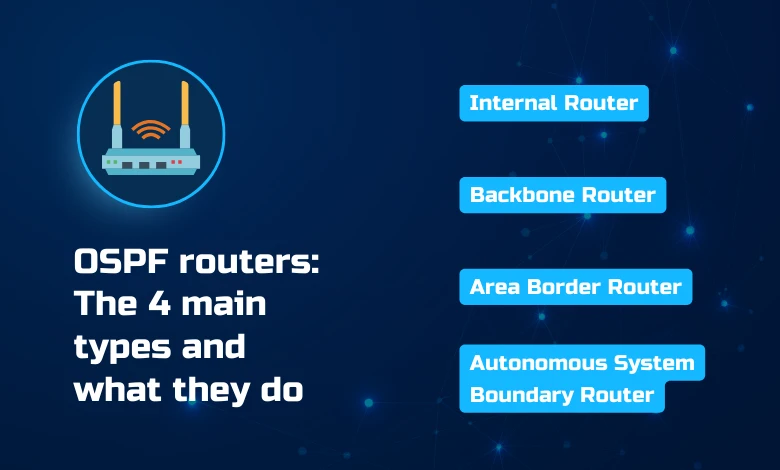OSPF routers are routers that use the Open Shortest Path First (OSPF) routing protocol to exchange routing information with other OSPF routers in the network. OSPF is a link-state routing protocol, which means that each OSPF router maintains a complete database of the topology of the network.
This database is used to calculate the best path to any destination in the network. OSPF routers are classified into four different types based
Table of Contents
Four Main Types Of OSPF Routers
Here are four main types of OSPF routers. Let’s discuss each type of OSPF router in-depth:
- Internal Router
- Backbone Router
- Area Border Router
- Autonomous System Boundary Router (ASBR):
Internal Router:
An internal router is a router that has all of its interfaces in the same area in an OSPF network. Internal routers are responsible for routing traffic within their own area. They do this by maintaining a link-state database (LSDB) of the topology of their area. The LSDB is used to calculate the best path to any destination in the area.
Internal routers communicate with each other using OSPF packets to exchange routing information. When an internal router receives an OSPF packet from another internal router, it updates its LSDB with the information in the packet. The internal router then calculates the best path to any destination in the area based on the updated LSDB.
Internal routers are the simplest type of OSPF router. They only need to maintain a link state database for their own area. Internal routers communicate with each other using OSPF packets to exchange routing information.
Here are some of the benefits of using internal routers:
- They are relatively simple to configure and manage.
- They are efficient at routing traffic within their own area.
- They are scalable, meaning that they can be used to route traffic in large and complex networks.
Internal routers are an essential part of any OSPF network. They play a critical role in providing scalable and efficient routing within different areas.
Backbone Router:
A backbone router is a router that resides in the backbone area of an OSPF network. The backbone area is a special area in OSPF that is used to provide a high-speed and reliable pathway for routing traffic between different areas.
Backbone routers typically have high bandwidth interfaces and are centrally located in the network. They are responsible for routing traffic between different areas and summarizing routing information. Backbone routers also play an important role in load balancing traffic between different areas.
Here are some of the benefits of using backbone routers:
- They provide a high-speed and reliable pathway for routing traffic between different areas.
- They help to load balance traffic between different areas.
- They can be used to create a redundant network topology, which can improve the overall reliability of the network.
Backbone routers are an essential part of any OSPF network that spans multiple areas. They play a critical role in providing scalable and efficient routing for traffic between different areas of the network.
Here are some examples of backbone routers:
- Cisco CRS-1
- Juniper MX-Series
- Huawei NE Series
- Alcatel-Lucent 7750-SR Series
Backbone routers are used by a variety of organizations, including:
- Internet service providers (ISPs)
- Enterprise networks
- Government networks
- Educational networks
Backbone routers are essential for the efficient and reliable routing of traffic across the Internet and other large networks.
Area Border Router:
An Area Border Router (ABR) is like a traffic cop in a big city, making sure cars can smoothly move between different neighborhoods. In the world of computer networks, ABRs connect different parts of a network, sort of like city neighborhoods, in a system called OSPF (that we will discuss in-depth). ABRs help these network neighborhoods talk to each other by keeping lists of all the streets and shortcuts in each neighborhood and then sharing those lists with the other neighborhoods.
ABRs have some important jobs:
- Keeping Neighborhood Lists: They keep separate lists of streets and shortcuts for each neighborhood they connect.
- Sharing the Lists: ABRs take all the information they know about the streets and share it with the other neighborhoods, making sure everyone knows about all the available paths.
- Choosing the Best Way: They figure out the quickest ways to get from one neighborhood to another and tell the network which paths to use.
- Directing Traffic: ABRs help guide the network traffic so it follows the best paths between neighborhoods.
Area Border Routers are like super important traffic managers in the network world. They’re set up as top dogs, so they make sure everything runs smoothly, helping data move efficiently between different parts of the network. In a nutshell, Area Border Router plays a vital role in making sure computer data gets where it needs to go, quickly and efficiently.
Autonomous System Boundary Router (ASBR):
An Autonomous System Boundary Router (ASBR) is a router that has at least one interface attached to an external network (other autonomous system), such as a non-OSPF network. ASBRs are responsible for advertising external routes into OSPF and learning external routes from other ASBRs.
ASBRs maintain a link state database (LSDB) for their own area and a separate link state database for the external network to which they are connected. ASBRs advertise external routes into OSPF using type 5 LSAs.
ASBRs play an important role in enterprise networks by providing a way to connect to other networks. They also play an important role in the Internet by providing a way for different networks to exchange routing information.
Benefits Of Using ASBRs:
- They allow you to connect your OSPF network to other networks, such as the Internet or other OSPF networks.
- They allow you to exchange routing information with other networks, which can improve the overall efficiency and reliability of your network.
- They can help to improve the security of your network by filtering external routes.
ASBRs are an essential part of any OSPF network that needs to connect to other networks. They play a critical role in providing scalable and efficient routing for traffic between different networks.
What Are The Benefits Of Using OSPF Routers:

There are several benefits of using OSPF Routers:
- Fast Convergence
- Load Balancing
- Security
- Wide Support
Fast Convergence:
OSPF uses a variety of mechanisms to quickly converge to a loop-free topology after a network change. This ensures that traffic is always routed over the best available path.
Load Balancing:
OSPF can load balance traffic across multiple equal-cost paths. This helps to improve the performance and reliability of the network.
Security:
OSPF supports authentication to prevent unauthorized routers from joining the network.
Wide Support:
OSPF is a widely supported routing protocol and is supported by a wide range of router vendors.
Conclusion:
OSPF routers are a critical component of any large and complex network. They offer a number of benefits, including scalability, efficiency, reliability, flexibility, fast convergence, load balancing, security, and wide support. OSPF routers are classified into four different types:
internal routers, backbone routers, area border routers, and autonomous system boundary routers. Each type of router plays a specific role in the network, and all four types are essential for providing reliable and efficient routing.
If you are designing or managing a large and complex network, you should consider using OSPF routers to provide scalable and efficient routing for your network traffic.

[…] OSPF networks are divided into areas to improve scalability and performance. Each area has its own link-state database (LSDB), which contains information about the topology of the area. ABRs maintain separate LSDBs for each area to which they are connected. […]